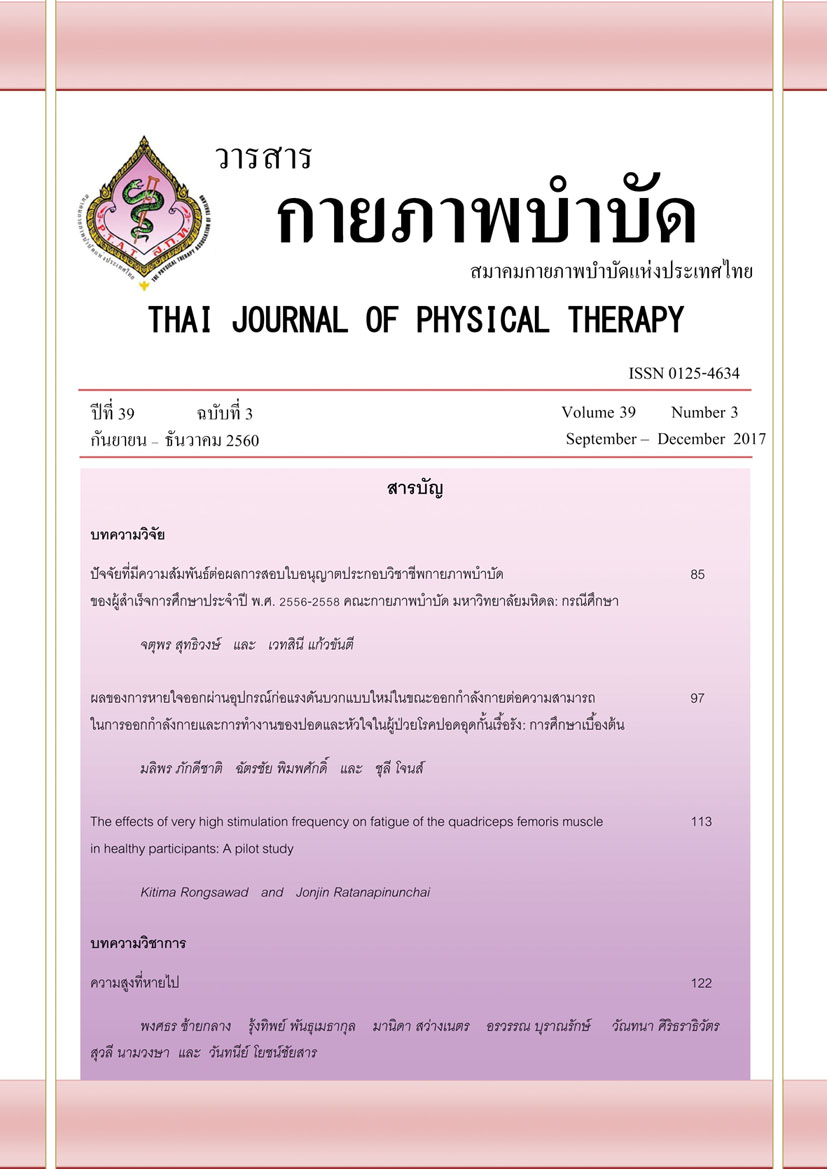ผลของการกระตุ้นด้วยกระแสไฟฟ้าความถี่สูงมากต่อการล้าของกล้ามเนื้อ quadriceps femoris ในผู้ที่มีสุขภาพดี: การศึกษานำร่อง
Main Article Content
บทคัดย่อ
ที่มาและความสำคัญ: ข้อจำกัดที่สำคัญในการกระตุ้นเส้นประสาทและกล้ามเนื้อด้วยกระแสไฟฟ้า (NMES) คือการเกิดการล้าของกล้ามเนื้อซึ่งการศึกษาที่ผ่านมาพบว่าความถี่ที่ใช้ในการกระตุ้นมีอิทธิพลต่ออัตราในเกิดการล้าของกล้ามเนื้อ อย่างไรก็ตามการศึกษาส่วนใหญ่มุ่งเน้นไปที่ความถี่ต่ำกว่า 100 Hz ผู้วิจัยมีสมมติฐานว่าการใช้ความถี่สูงมาก อาจทำให้เกิดการระดมของหน่วยประสาทยนต์แบบไม่พร้อมกัน และเกิดการล้าไม่ต่างหรือน้อยกว่า
วัตถุประสงค์: เพื่อศึกษาผลของการกระตุ้นไฟฟ้าโดยใช้ความถี่สูงมาก (150 และ 200 Hz) และความถี่ต่ำ (50 Hz) ต่อการลดลงของแรงการหดตัวของกล้ามเนื้อที่ถูกกระตุ้น
วิธีการ: อาสาสมัครสุขภาพดีจำนวน 9 คนได้รับการทดสอบการล้าของกล้ามเนื้อโดยใช้ความถี่ในการกระตุ้น 3 ช่วงได้แก่ 50, 150 และ 200 Hz ร่วมกับการใช้ช่วงกระตุ้นกว้าง (0.9 ms) เป็นเวลา 15 นาที การล้าของกล้ามเนื้อประเมินโดยใช้ค่าแรงหดตัวของกล้ามเนื้อ (normalized force) เมื่อสิ้นสุดโปรแกรมการทดสอบในแต่ละความถี่
ผลการศึกษา: ไม่พบความแตกต่างของการล้าของกล้ามเนื้อเมื่อเปรียบเทียบระหว่างการกระตุ้นที่ใช้กระแสไฟฟ้าความถี่สูงมาก (150 และ 200 Hz) และความถี่ต่ำ (50 Hz) ร่วมกับการใช้ช่วงกระตุ้นกว้าง ในการทดสอบการล้านาน 15 นาที
สรุปการศึกษา: การศึกษาครั้งนี้แสดงให้เห็นว่าการกระตุ้นไฟฟ้าโดยใช้ความถี่สูงมากและความถี่ต่ำร่วมกับการใช้ช่วงกระตุ้นกว้างมีผลต่อการล้าของกล้ามเนื้อไม่แตกต่างกัน การศึกษาเพิ่มเติมเพื่อยืนยันผลในกลุ่มอาสาสมัครขนาดใหญ่เป็นสิ่งจำเป็น
Article Details
เอกสารอ้างอิง
Chae J, Sheffler LR, Knutson JS. Neuromuscular electrical stimulation for motor restoration in hemiplegia. Top Stroke Rehabil. 2008; 15(5): 412–26.
Glanz M, Klawansky S, Stason W, Berkey C, Chalmers TC. Functional electrostimulation in poststroke rehabilitation: a meta-analysis of the randomized controlled trials. Arch Phys Med Rehabil. 1996; 77(6): 549–53.
Glinsky J, Harvey L, Van Es P. Efficacy of electrical stimulation to increase muscle strength in people with neurological conditions: a systematic review. Physiother Res Int. 2007; 12(3): 175–94.
Maffiuletti NA. Physiological and methodological considerations for the use of neuromuscular electrical stimulation. Eur J Appl Physiol. 2010; 110(2): 223–34.
Kesar T, Binder-Macleod S. Effect of frequency and pulse duration on human muscle fatigue during repetitive electrical stimulation. Exp Physiol. 2006; 91(6): 967–76.
Dreibati B, Lavet C, Pinti A, Poumarat G. Influence of electrical stimulation frequency on skeletal muscle force and fatigue. Ann Phys Rehabil Med. 2010; 53(4): 266–77.
Gregory CM, Dixon W, Bickel CS. Impact of varying pulse frequency and duration on muscle torque production and fatigue. Muscle Nerve. 2007; 35(4): 504–9.
Matsunaga T, Shimada Y, Sato K. Muscle fatigue from intermittent stimulation with low and high frequency electrical pulses. Arch Phys Med Rehabil. 1999; 80(1): 48–53.
Russ DW, Vandenborne K, Walter GA, Elliott M, Binder-Macleod SA. Effects of muscle activation on fatigue and metabolism in human skeletal muscle. J Appl Physiol. 2002; 92(5): 1978–86.
Gorgey AS, Mahoney E, Kendall T, Dudley GA. Effects of neuromuscular electrical stimulation parameters on specific tension. Eur J Appl Physiol. 2006; 97(6): 737–44.
Scott WB, Causey JB, Marshall TL. Comparison of maximum tolerated muscle torques produced by 2 pulse durations. Phys Ther. 2009; 89(8): 851–7.
Gorgey AS, Dudley GA. The role of pulse duration and stimulation duration in maximizing the normalized torque during neuromuscular electrical stimulation. J Orthop Sports Phys Ther. 2008; 38(8): 508–16.
Dean JC, Yates LM, Collins DF. Turning on the central contribution to contractions evoked by neuromuscular electrical stimulation. J Appl Physiol. 2007; 103(1): 170–6.
Collins DF. Central Contributions to Contractions Evoked by Tetanic Neuromuscular Electrical Stimulation: Exerc Sport Sci Rev. 2007; 35(3): 102–9.
Martin A, Grosprêtre S, Vilmen C, et al. The Etiology of Muscle Fatigue Differs between Two Electrical Stimulation Protocols. Med Sci Sports Exerc. 2016; 48(8):1474–84.
Reed B. The Physiology of Neuromuscular Electrical Stimulation. Pediatr Phys Ther. 1997; 9(3): 96–102.
Guyton AC. Textbook of medical physiology. 11th ed. Philadelphia: Elsevier Saunders; 2006.
Borg J. Refractory period of single motor nerve fibres in man. J Neurol Neurosurg Psychiatry. 1984; 47(4): 344–48.
Kimura J, Yamada T, Rodnitzky RL. Refractory period of human motor nerve fibres. J Neurol Neurosurg Psychiatry. 1978; 41(9): 784–90.
Willems MET, Ponte JPG. Divergent muscle fatigue during unilateral isometric contractions of dominant and non-dominant quadriceps. J Sci Med Sport. 2013; 16(3): 240–4.
Wegrzyk J, Fouré A, Fur YL, Maffiuletti NA, Vilmen C, Guye M, et al. Responders to wide-pulse, high-frequency neuromuscular electrical stimulation show reduced metabolic demand: A 31 P-MRS study in humans. PLOS ONE.2015; 10:e0143972. doi:10.1371/journal.pone.0143972.


